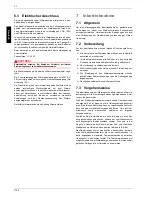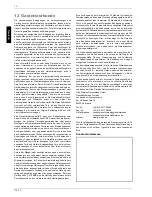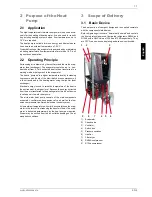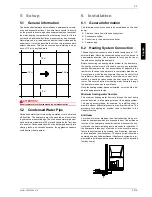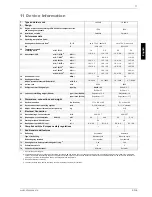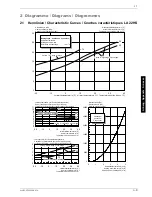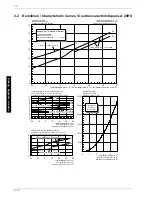
EN-8
English
8.3
8.3 Cleaning the Air System
Evaporator, ventilator and condensate outflow should be cleaned
of contamination (leaves, twigs, etc.) before each new heating
period. Do this by opening the front of the heat pump. The bottom
should be opened first followed by the top.
ATTENTION!
Before opening the device, ensure that all circuits are isolated from the
power supply.
Remove and rehang the side panel assemblies as described in
Chapter 4.
To prevent the evaporator and the condensate tray from being
damaged, do not use hard or sharp objects for cleaning.
Under extreme weather conditions (e.g. snow drifts), ice may
form on the air intake and exhaust air outlet grids. If this happens,
the ice must be removed in the vicinity of the air intake and ex-
haust air outlet grids to ensure that the minimum air flow rate is
maintained.
8.4 Maintenance
Devices with a minimum of 3 kg refrigerant, or hermetically
sealed devices with a minimum of 6 kg refrigerant must be leak-
proof tested yearly by the operator according to ES842/2006.
The leak-proof testing is to be documented and archived for a
minimum of 5 years. The test is to be carried out by certified per-
sonnel only according to (EG) Nr. 1516/2007. The attached table
can be used as a basis for the documentation.
9 Faults / Trouble-
Shooting
This heat pump is a quality product and is designed for trouble-
free and maintenance-free operation. In the event that a fault
should occur, it will be indicated on the heat pump manager dis-
play. Simply consult the Faults and Trouble-shooting page in the
operating instructions of the heat pump manager. If you cannot
correct the fault yourself, please contact your after-sales service
technician.
ATTENTION!
Any work on the heat pump may only be performed by authorised and
qualified after-sales service technicians.
10 Decommissioning/
Disposal
Before removing the heat pump, disconnect it from the power
source and close all valves. Observe all environmentally-relevant
requirements regarding the recovery, recycling and disposal of
materials and components in accordance with all applicable
standards. Particular attention should be paid to the proper dis-
posal of refrigerants and refrigeration oils.



